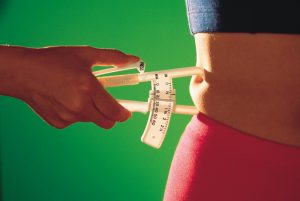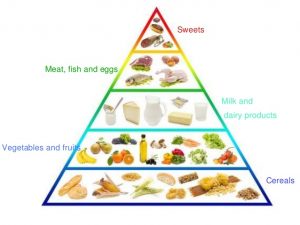An American university research study, and other experiments, concluded that the taste for fatty foods can be disposed of very quickly. A thousand women reduced their fat intake to 25 percent or less (after a previous norm of about 40 percent or more). After six months on this low-fat diet, the women reported that they new actually disliked high-fat foods. Side effects from switching to a high-fat diet from a low-fat diet include severe indigestion, heartburn, constipation and chronic lethargy – as well as immediate weight gain.
Here then, are our tested ways to help you reduce the fat in your diet.
Make changes gradually

Sponsored Links
Although the ‘kill or cure’ approach works for some people, usually the best method for change is ‘little by little’. Also, as your digestive system takes time to adapt to a different diet, this makes sense physically as well as emotionally. And it makes sense in a third way: your palate will then painlessly adapt to what you offer it.
Here are a couple of examples of making changes gradually rather than quickly:
You decide to cut down on fat by using skimmed milk instead of whole milk. But your palate tells you you dislike the skimmed milk in your tea and on your cereals: it doesn’t ‘taste right1. So you go back to your whole milk. What you should have done was choose semi-skimmed milk as a compromise for a few weeks and then tried the fully skimmed.
You decide that one of the reasons your fat intake is high is your love of biscuits, so you determine to cut them out. But after a day or two you are craving biscuits, so you start eating them even more avidly than before. What you should have done was either replace your biscuits with a lower-fat, lower-calorie kind (if possible) or cut down the number (perhaps by buying them individually wrapped).
Make changes gradually so you have time to get accustomed to them in every way. After a time they are incorporated into your life as if they are habits you have always had.
Make swops in what you buy

Although it is the case that you are, largely (perhaps very largely!), what the food industry has made you, the good news is that if we show the food industry – through what we buy in the supermarkets – that what we want is lower fat, lower sugar, healthier produce, then eventually that message will get through and the shelves will reflect our wishes.
That means making a determined and wholesale effort to shop the new-style way.
Sponsored Links
Since there is only profit to be made in manufacturing and selling packets of cream cakes or trifle mixes and the like if the products disappear from the shop shelves, any line that sits there for too long gets replaced by something that will sell.
Already all the supermarkets and most of the smaller shops are offering reduced-fat, reduced- sugar, reduced-calorie versions of high-fat, high-cal, high-sugar foods, yet still it is frequently more difficult for us to locate these lines than the traditional versions. However, the most popular of the reduced-fat items, the ones with which we are very familiar, are big sellers and are therefore stocked just as prominently as their counterparts, skimmed milk and reduced-fat spreads being the two that come to mind first.
The following are all swops that will save masses of fat calories:
- Low-fat spread instead of butter/ordinary margarine
- Low-fat yogurt instead of whole-milk yogurt
- Lower-fat cheeses instead of traditional cheeses
- Lean cuts meat instead of the traditional cuts
- Tuna in brine instead of tuna in oil
- Low-fat crisps instead of regular crisps
- Spraying oil instead of cooking oil
- Lower-fat dressings instead of full-fat versions
Make swops in how you cook

You can cut out even more fat from your cooking by using the following methods:
- Dry-fry, don’t deep-fry: Many things that you used to fry can nowadays be oven-baked, but, if you don’t want to do that, the next best thing is to dry-fry. You need a good, heavy-bottomed, non-stick frying pan and a tiny brushing of oil (or the new spray-on oil). Once the pan is heated, many foods, from fish to saute potatoes, can be cooked this way.
- Grill fatty foods, don’t fry them: You’ll cut out even more fat calories if you grill, say, a slice of bacon over a slatted splash guard so that the fat in the meat melts, runs through the slats and is easy to discard. Grill foods such as bacon and sausages until really well done in order to eliminate even more fat.
- Experiment with methods that reduce the fat or oil content in your favorite recipes: Many new-style recipes for you to try are included in Step Four, but almost any recipe can be adapted in a similar way. For instance, if you’re browning onions or meat for a casserole, you could reduce the specified fat or oil down to nearly nothing, especially if you use non-stick cookware. Also, many soup recipes suggest frying the vegetables first in oil, but you can usually omit this step and simply simmer them in stock before blending.
- Casseroles can be made in advance, left in the fridge and then any solid fat that appears on the top is easily removed.
- Use reduced-fat cooking spread for baking.
All these things are easy to do and won’t detract from the taste of your cooking at all.
New-style balance

Much smaller steak or slices of roast meat; much larger portion of potatoes; at least two helpings of vegetables; a very small knob of butter on the potatoes, and fat-free gravy over the rest of the plate to avoid dryness.
You can alter the balance in other ways, too. Instead of that steak-and-potatoes meal, try one that is based on carbohydrates – say, a big plate of spaghetti or rice topped with a vegetable stir-fry containing just a very little meat.
Make changes you are most able to live with

Sponsored Links
Some of the suggestions we make may seem easier, more pleasant and more practical to you than others. Work first on the ones that seem easiest. Everyone is different; your diet doesn’t have to be exactly the same as everyone else’s. Your preferences matter. If you don’t take account of them you won’t succeed in losing weight and keeping it off. You’re not being asked to sacrifice everything you hold dear, but only to look and see if there are ways of improving your diet and to understand that your taste in food can alter.
If, after giving something – say, low-fat spread – a fair trial, you just can’t get on with it, well, don’t worry, you don’t have to eat low-fat spread to get slim.
